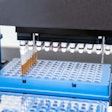
Most of the revenue in the IVD market is generated by fewer than 20 companies, according to a recent report by IVD market research firm Kalorama Information, a sister company of LabPulse.com.
 Bruce Carlson from Kalorama Information.
Bruce Carlson from Kalorama Information.In recent years, this group of top-tier companies has increased its ownership position of the market. At the same time, Kalorama found that there are still opportunities for new companies. Roche and Abbott are world market leaders, according to the firm's report titled "Worldwide Market for In Vitro Diagnostic Tests," published in August.
Other top companies include Siemens Healthineers and Danaher (with subsidiaries Cepheid, Beckman Coulter, Radiometer, and Leica Biosystems), as well as Thermo Fisher, Ortho Clinical Diagnostics, Bio-Rad, bioMérieux, Sysmex, Agilent, and Hologic. These large companies sell multiple tests, achieve large placements in laboratories, and have a history of selling IVD or have acquired companies that did.
The trend is due to perfection of production, expert distribution, and acquisition of companies. Large companies -- those over $500 million in IVD revenue -- grew at 7% in the last five years, slightly higher than the average growth rate of 4% for IVD during that time, per the report.
In 2019, the top IVD companies accounted for some $56.9 billion of IVD product sales. While 2020 is not yet complete, Kalorama estimates that $67 billion dollars will be earned by top companies. Part of this development is related to organic company growth, but it is also due to market expansion and strategic acquisitions that add a revenue stream and product innovations.
Even in pandemic-based COVID-19 testing, consolidation is reflected. About 10 companies (Roche, Abbott, Cepheid, and bioMérieux, among them) were among lab-favored tests, at least in the U.S., according to a recent Association for Molecular Pathology (AMP) survey.
That doesn't mean there aren't billions of dollars available for other concerns. The remainder of the market, still 15%-20% and worth billions, is held by hundreds of companies, some of which specialize in specific test segments or serve their local markets. There are constant innovators and start-up companies, and millions of dollars are spent each year in IVD research and development. This fuels new products; next to stents, the most common new device application to the U.S. Food and Drug Administration (FDA) is for IVD tests or test-related devices.
New companies are entering the IVD market at a rapid pace. Nearly 200 products for COVID-19 (not including laboratory-developed tests) have been authorized by the FDA. These are mostly small operations, but large companies have also entered IVD in some form or another this year, including Amazon, Eli Lilly, Ford, and the Mayo Clinic, along with well-known life science names such as Sherlock, WuXi Biologics, Promega, and Agena Biosciences. Guardant Health and Biocept have moved from oncology operations to infectious disease testing due to the virus. Imaging player Fujifilm entered IVD with a recent acquisition unrelated to the pandemic.
Companies in the top of the market can change, according to the report. Quidel, Mindray, Perkin Elmer, and Bruker are spoken of in the IVD market at a level they would not have been a decade ago. All have improved diagnostic revenues in recent years.
More information can be found in the 13th edition of Kalorama's IVD market report, "Worldwide Market for In Vitro Diagnostic Tests."
Bruce Carlson is the publisher of Kalorama Information, part of Science and Medicine Group.
Disclosure: LabPulse.com is a sister company of Kalorama Information.



















